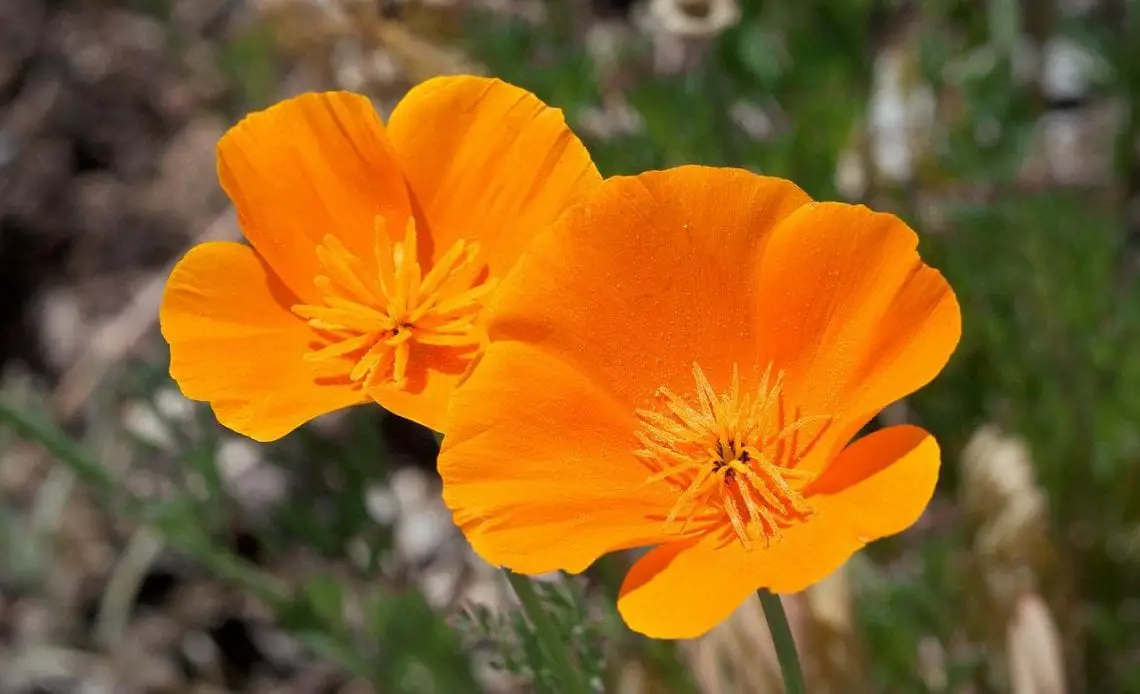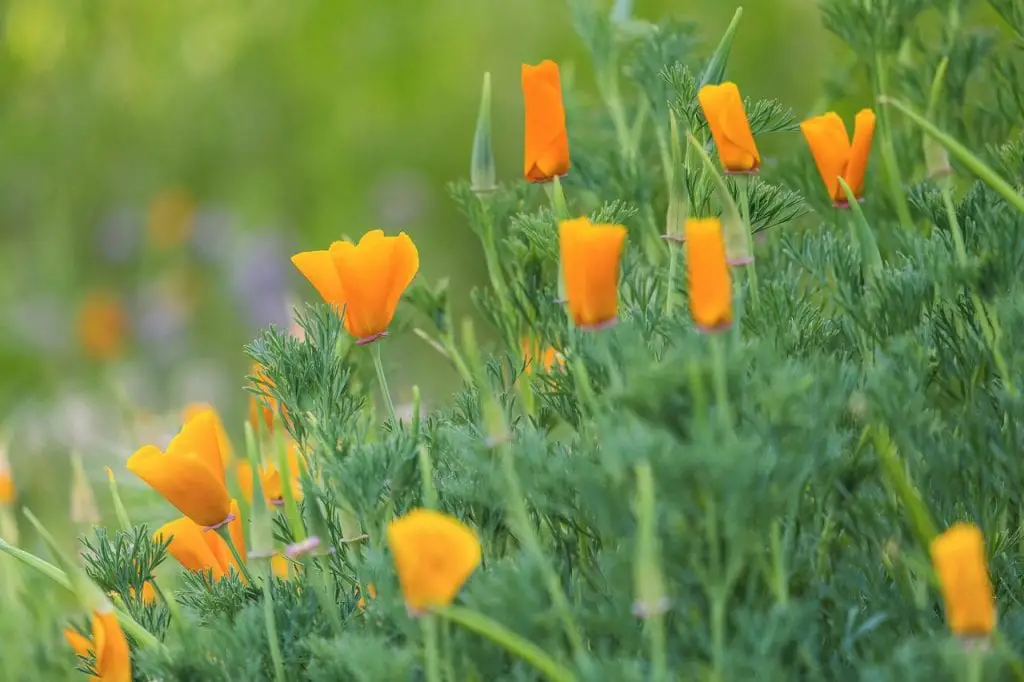
The golden poppy or the pretty wildflower that is commonly called California poppy is definitely one of the most beautiful flowers out there. If you would like to add a pop of color to your flower bed, then the golden blooms of this plant can be your best choice. Growing a wild flowering plant like this would be easy. Even in poor quality soil, you would find this plant thrive. So, are you ready to learn about California poppy growth and care instructions?
A sneak-peek into the ideal growing conditions for California poppy
· Sunlight needs – ample sunlight
· Watering requirements – sparse watering – weekly or bi-weekly when the weather is hot
· Fertilization – requires no fertilizers
· Scientific name – Eschscholzia californica
· Origins – Mexico and the US
California Poppies planting requirements
Soil conditions
Like every other wild plant that crops up in the ignored grasslands, this one too grows without any trouble in average soil conditions. Even in the rugged terrains with rocky soils or those where the soil is loose and sandy these plants can grow well.
You would also not have to bother about fertilizing the soil. Fertilizing the soil might result in the development of healthy foliage. However, this sometimes leads to the denser growth of foliage and reduction in the blooms. Nutrient deficient soil where all other plants fail can still be a good medium for California poppies planting. Choose any average quality soil from the garden to plant your California poppy seeds. If you are planning to grow them in containers, pick those that have good drainage. Clay soils might restrict the healthy growth of the root system and thus you might notice stunted growth or even reduced rate of flowering.
Sunlight
This is a plant that thrives in bright sunlight. Choose a sunny spot in your garden and your plant would grow without any trouble. Especially during the flowering season, the plant needs as much sunlight throughout the day as possible. The longer the exposure to the sun, the happier would the blooms be.
If you pick these poppies as fillers in your plant bed, you should only consider the sunlight exposure. Make sure that choose those spots that receive maximum sunlight throughout the day, at least for 6 hours. Do not plant them directly below trees or close behind tall bushes and hedges. If your poppies would be raised in a container avoid placing them in shady spots. You might miss out on the healthy blooms of California poppies if you place the container in a shady porch. Unfiltered sunlight would make these plants happy and increase the flowering rate.
Watering

Being a drought-tolerant plant, it grows well even when neglected. With its taproot system, the plant is very good at utilizing whatever moisture is present in the soil. You only have to water the plants during the growing season, when the plant is still young and when the plant is actively blooming.
You can treat this plant similar to most succulent varieties. It only needs to be watered once a week during hot and dry summers. During colder weather conditions you can reduce the watering frequency to once in 3 weeks. It can therefore add a fresh new dimension to your succulent garden with its burst of colors and the hardiness. If you live in a place that receives occasional rainfall during spring, then your plants would grow healthy.
Remember that this is a plant that doesn’t tolerate soggy soil conditions. Stagnant water can weaken the root system or even lead to mildew problems. This again reiterates the need for good drainage when you grow these plants in containers. During the summer months once the flowering stops the plant’s growth slows down. This is the time when weekly watering might not be required. If you live in the coastal areas and places where summers are not particularly dry, you can skip watering your poppy beds the whole of summer.
Other growing conditions
As a plant that can grow well in drought-like conditions, this one is not for areas that receive constant rainfall. Temperatures between 50-75℉ are ideal for the healthy growth of this plant. As the temperature increases the growth stops and puts the plant in a dormant stage. It doesn’t require too much humidity and can manage pretty well in dry weather conditions.
Best ways to propagate California poppy
California poppy can be propagated from the seed. These plants can be directly planted in the garden or raised indoor in the seedling stage. If you choose to grow them in coir seedling pots transplant them to your flower beds once you notice sprouting. Right from this stage, the plant needs enough sunlight all day long. You might have to make sure that the plant gets enough water at this stage and you can gradually reduce watering as the plant grows bigger. To start these plants from seeds-
· Pick the sunniest spot in your garden
· Place the seeds in shallow grooves
· You only need to add a narrow layer of soil on top of the seeds
· You can start transplanting and thinning the seedlings as soon as the growth reaches around 2inches in height
Once fully grown self-seeding is common with these plants. So, if you space out the poppy bed with enough gap between each plant you should have a rich-looking bed lining your garden borders after a few flowering seasons. This is how the plant spreads in the neglected grasslands and gardens.
Raising California poppies in containers
This hardy plant can grow outdoor in your flower beds and also in containers. But the limitation when it comes to growing in containers is the shorter lifespan. It doesn’t go dormant and regrow and bloom during the next spring season as with poppies raised in the garden. You can therefore consider it as an ornamental flowering plant that can give flowers throughout spring and parts of summer. When raised in a container it is more of an annual than a perennial. This is mainly because of the lack of space for the roots to branch out and keep the plant alive during the winter months.
Pruning and maintenance of California poppy beds
After California poppies planting is done, you should also focus on the maintenance of the flower bed. You might not have to stress too much about pruning and maintaining these plants as you would have to do with other flower bushes. However, in order to facilitate healthier root systems, you can cut back on the plants such that there is a sufficient gap between each plant. This helps in making the plant self-reliant in terms of the water requirements.
Caring for your California poppies and protecting them from common plant diseases
California poppies planting involves the ease of maintenance when it comes to plant disease management. This is one of the very few flowering plants that are disease-resistant. There are not many bugs and pests that attack this plant. Staying true to its wild nature this plant is pretty sturdy. Aphids are not uncommon with California poppies. But if you have ladybugs in your garden, you can forget about these pesky insects raiding your plants. Leafhoppers and other bugs on these poppies do not affect the flowering and growth of the plant.
The only problem that you should worry about when you nurture golden poppies would be dusty mildew. This happens when you enthusiastically overwater the plants. This can also be subject to root rot which is one of the most common causes of dwindled growth and eventual death of these plants.
Though fertilization is not required, you should apply mild organic fungicides on a regular basis. This will help in preventing the stunted growth of the plant and improve the quality of blooms in the plant.
California Poppy fun facts
· Yellow or golden blooms are the most common varieties in this plant. There are also red and orange variants available. If you are lucky you could even stumble upon the rare yet pretty pink variant of this flower.
· Some parts of this plant are edible, especially the oil that is extracted from its seeds.
· You would find some bakers use the seeds of the golden poppy flowers for garnishing. All the edible parts of the plant are only consumed in moderation as excess doses can lead to illness.
· Medicinal values of poppies are well-known around the world
· In the year 1903, this flower was named California’s state flower. This is where it gets its name.
· The blooms droop quickly when plucked from the plant. So, you might not find these flowers in floral arrangements or even in bouquets.
As a bright and cheerful plant, you would be able to incorporate California poppies in so many ways in your garden. California poppies planting requirements are easy to understand and so even amateur gardeners can enjoy a good success rate cultivating it. Nurture this beauty from seeds or bring home a young poppy plant from your local nursery. It is sure to delight you with its chirpy blooms all the way from spring through summer.
